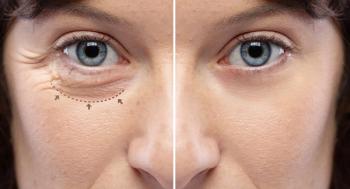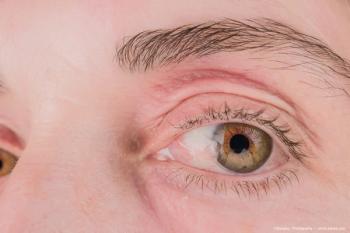
- Ophthalmology Times: July/August 2025
- Volume 50
- Issue 4
What the eyes reveal: Cardiovascular clues in women—hidden in plain sight
Key Takeaways
- Ocular exams can reveal cardiovascular health issues, especially in women, whose symptoms often differ from traditional expectations.
- Women may experience atypical cardiac symptoms, and structural differences in their cardiovascular systems contribute to unique disease presentations.
Hidden signs of systemic disease, including heart attacks, may first reveal themselves through visual symptoms or subtle patient cues in the exam chair.
As emerging research and real-world cases show, the eyes can offer a critical window into cardiovascular health—especially for women, whose symptoms and disease patterns often defy conventional expectations. The exam chair is more than a place to treat
Until recently, cardiac disease was defined by the symptoms that manifested in men. The classic expectation has been crushing or squeezing chest pain. Other possible symptoms were arm, neck, or jaw pain; dyspnea; fatigue; nausea; sweating; and dizziness, according to the American Heart Association (AHA).1
In women, however, the clinical picture often can differ substantially from what was considered the norm. Although chest pain still remains the first symptom, that is not the case for many women. Importantly, among those with chest pain, the sensation may be different, in that women may describe it as pressure or tightness and therefore write it off as a passing anomaly other than a cardiac event. 2 Other symptoms that women experience include pain or pressure in the lower chest or upper abdomen; jaw, neck, or upper back pain; nausea or vomiting; shortness of breath, fainting; cold sweats; indigestion; and extreme fatigue.2
Several factors contribute to the differences in how cardiac disease affects men and women, according to the Cardiology Department at Brigham and Women’s Hospital in Boston, Massachusetts. In addition to variations in symptoms, structural and physiological differences between the sexes help explain why heart disease may present and progress differently in women.3
The cardiovascular systems of the 2 sexes differ: Women’s hearts are smaller, and the blood vessels are narrower. The Atherosclerosis Risk in Communities Study concluded that retinal arteriolar narrowing is related to the risk of coronary heart disease (CHD) in women but not in men, supporting a more prominent microvascular role in the development of CHD in women than in men. Future work is needed to confirm these findings.4
Cholesterol accumulates in different areas in men and women. In women, this accumulation is more likely to be in the microvasculature, whereas the buildup occurs in the largest arteries for men.
There are diseases that may mimic a heart attack in women, such as a coronary spasm, coronary dissection, and broken heart syndrome, the last of which is not characterized by blocked arteries.
Differences in risk factors for cardiac disease, such as preeclampsia, gestational diabetes, and endometriosis, exist in women.3 Regarding the last risk factor, a recent study reported, “…our data show that endometriosis is associated with higher risk of coronary heart disease independent of known and hypothesized confounders and coronary heart disease risk factors, especially among younger women. Moreover, we also observed that a portion of this association could be explained by treatment factors associated with endometriosis diagnosis, particularly hysterectomy/oophorectomy.”5
Different diagnostic heart care is needed for men and women. Troponin testing is done for both men and women to measure the serum levels of this protein. However, the threshold levels of the protein to detect a heart attack differ between men and women. One study showed that “using the common 99th percentile can lead to underdiagnosis of acute coronary syndrome in women, [as] their physiological levels of cardiac troponins are much lower. At the same time, the use of the 99th percentile, without considering the gender factor, leads to overdiagnosis of the acute coronary syndrome in men, which is due to higher physiological levels of cardiac troponins in the blood,” according to the authors.6
Cardiac catheterization is the gold standard for diagnosing a heart attack, but this test looks for blockages in large arteries. Because plaque buildup in women is more likely to develop in the smallest arteries, this test may not be the most appropriate to diagnose heart disease in women. Women are advised to seek further testing if the cardiac catheterization seems inconclusive, such as cardiac MRI to identify cardiac inflammation or intracoronary imaging to view the inner blood vessel walls in the heart.3
Different treatments for cardiac disease may be needed for men and women. Clinicians successfully treat plaque buildup with medications targeting the largest cardiac blood vessels. However, treating the microvasculature or cardiac inflammation is less well understood. Subtle calibrations in pacemakers or variations on angioplasty may be useful for women.
When those differences hit home
Case 1
Karen S. DeLoss, OD, FAAO, is a clinical associate professor of ophthalmology and visual sciences at the University of Michigan Medical School in Ann Arbor. Her case is illustrative of the scenarios that many women describe.
She is a 47-year-old practitioner with an unremarkable clinical history with no underlying cardiac issues. In June 2024, she experienced “very subtle” symptoms that included indigestion, mild discomfort that she considered tolerable, and mild chest pain—all so minor that they did not indicate a heart attack. She took an aspirin and reported that the symptoms persisted for about 2 hours. As a precaution, she presented to the emergency department (ED), where blood work was performed. She was not convinced that she was having a cardiac event and thought it was a panic attack. After about 5 hours in the ED, the blood work showed increasing troponin levels (approximately 200 ng/L). Normal troponin levels for women are below 10 ng/L. By later that evening, her troponin level was 700 ng/L.
The following morning, cardiac catheterization was recommended with the possibility of stent placement. Open heart surgery was also an option.
The catheterization identified a spontaneous coronary artery dissection (SCAD), which is common in women. In this case, the dissection was minimal and located in the distal left anterior descending artery. She was discharged from the facility with medications and cardiac monitoring.
“With research, I realized that this scenario is common in perimenopausal women under high stress. In this case, there is no major treatment, and the risk of recurrence is low,” DeLoss said.
Some women with this diagnosis have an underlying disorder called fibromuscular dysplasia or Marfan syndrome. She was followed by the SCAD specialist and treating cardiologist and underwent renal scans and echocardiography, which were negative. Evaluation of lipoprotein(a) (normal, less than 40-50 mg/dL) returned an extremely high value (150 mg/dL), which is a risk factor for cardiovascular disease, especially heart attack and stroke, and linked to premature heart disease; lipoprotein(a) values are genetically determined. This factor might have been associated with her cardiac event. She will continue to be followed annually.
Case 2
This patient was a 75-year-old woman whose presenting symptoms included extreme anxiety, profuse sweating, and black spots in the visual field. The patient denied chest/jaw/arm pain, labored breathing, dizziness, and fatigue. The patient reported maintaining a healthy diet, eliminating red meat, weight control, and regular exercise because of a history of heart disease on both sides of her family.
After admission to the ED, an electrocardiogram (ECG) showed an ST-segment elevation myocardial infarction, which, in this case, was complete thrombotic blockage of the right posterior descending artery. Upon arrival in the cardiac catheterization laboratory, she was hypotensive and in cardiogenic shock and developed complete heart block that resolved with balloon angioplasty and placement of 3 stents. Following discharge, new-onset atrial fibrillation developed that was treated with infused amiodarone 150 mg. ECG demonstrated sinus rhythm with improvement of the previously seen ST elevations. Echocardiogram showed no evidence of heart failure. The patient is currently being followed 3 times annually.
Genetics was believed to have played a role in this case, because the patient’s mother died from a plaque rupture that affected the right posterior descending artery.
What is noteworthy in both patients is that there was no immediate recognition that a heart attack was occurring because they had taken such care to avoid one. “I gaslighted myself. I had uncomfortable pain but talked myself through it,” DeLoss said.
Patient advocacy
In light of this denial, DeLoss, a dry eye specialist, uses her clinical position to her advantage to educate her female patients about heart disease. In her practice, she believes in treating the entire patient over and above blood pressure and diabetes. For example, dry eye can be related to underlying Sjögren syndrome, lupus, or, in some cases, have no known cause as of today.
The event has changed her approach to patient care; she now takes the time to reach out to patients who may have significant ocular conditions and follows up personally with test results. She feels this may ease anxiety in her patients and lead to better adherence with their eye care in the future. It may be a small personal touch but perhaps a big impact on her patients, she explained.
In her case, she ultimately presented to the ED because she heard of another young woman who experienced a heart attack; the patient had exercised good eating and exercise habits, did not smoke, and believed that she could not experience a heart attack.
A great deal of research is now emerging about how women with cardiac issues present, DeLoss said. “The benchmark in the past was based on men’s presentations. The movement now is that the differences between men and women are being evaluated regarding reactions to cardiac issues,” she said.
She advises ophthalmologists and optometrists not to overlook young women when advising patients about cardiac health.
Manifestations of potential cardiac disease in the eye
The American Osteopathic College of Dermatology7 describes xanthelasma as a well-circumscribed flat or slightly elevated yellowish growth consisting of cholesterol deposits. Approximately half of patients with xanthelasma have elevated lipid levels, which are commonly associated with hereditary forms of high cholesterol or certain liver diseases. The college noted that small studies suggested xanthelasma may be a risk factor for death from CHD, even if cholesterol levels are normal. However, more studies are needed to confirm this.
Arcus senilis is observed as a white or gray ring around the cornea and can be a sign of high cholesterol in young patients,8 possibly indicating familial hyperlipidemia. Elevated blood pressure can damage the retinal vessels and nerves because of poor blood flow and block the arteries and veins that service the retina.9 Heart conditions can also disrupt blood flow to the eyes, leading to blurred or temporary loss of vision, which may indicate a stroke or transient ischemic attack.10
Retinal artery occlusion (RAO) is strongly linked to heart disease and stroke, often acting as an early warning sign of these conditions. A recent study reported an increased risk of death, stroke, and myocardial infarction in patients with RAO at both short-term and long-term intervals after RAO compared with a matched control population diagnosed with cataract. These findings suggest a potential need for multidisciplinary evaluation and long-term systemic follow-up of patients post RAO.11
Amaurosis fugax is a temporary loss of vision in 1 or both eyes that can be a sign of underlying vascular disease, potentially related to heart problems.12 Although amaurosis fugax is not itself a disease, it is a sign of other disorders that are present. Amaurosis fugax can occur from different causes, one of which is the blockage of an artery in the eye by a blood clot or a piece of plaque. The blood clot or plaque usually travels from a larger artery, such as the carotid artery in the neck or an artery in the heart, to an artery in the eye.
A rare ocular phenomenon is the pupil dilation and constriction in synchrony with the heartbeat, called Landolfi sign.13 In severe cases of patients with aortic regurgitation caused by a leaky heart valve, small amounts of blood leak backward into the heart instead of being pumped into the body. Symptoms typically include fatigue and breathlessness. Hypertensive retinopathy, diabetic retinopathy, and age-related macular degeneration can also be linked to heart disease.14
DeLoss advised ophthalmologists and optometrists to look beyond the ocular examination. She also recommended viewing an AHA video titled “Just a Little Heart Attack.”15
“Trust your gut. Engage your patients. They know their bodies. Listen to them to unearth potential cardiovascular issues that may be lurking before the disease is in full bloom to save patients’ lives,” DeLoss concluded.
Karen S. DeLoss, OD, FAAO
E: [email protected]
DeLoss is a clinical associate professor of ophthalmology and visual sciences at the Brighton Center for Specialty Care at the University of Michigan Medical School in Ann Arbor. She has no financial interest in the subject matter.
References
Warning signs & symptoms in women. Go Red for Women. Accessed June 27, 2025.
https://www.goredforwomen.org/en/about-heart-disease-in-women/signs-and-symptoms-in-women Symptoms of a heart attack in women. Go Red for Women. Reviewed January 31, 2024. Accessed June 27, 2025.
https://www.goredforwomen.org/en/about-heart-disease-in-women/signs-and-symptoms-in-women/symptoms-of-a-heart-attack O’Donoghue S. Heart disease: 7 differences between men and women. Brigham and Women’s Hospital. Accessed June 27, 2025.
https://give.brighamandwomens.org/7-differences-between-men-and-women/ Wong TY, Klein R, Sharrett AR, et al. Retinal arteriolar narrowing and risk of coronary heart disease in men and women. The Atherosclerosis Risk in Communities Study. JAMA. 2002;287(9):1153-1159. doi:10.1001/jama.287.9.1153
Mu F, Rich-Edwards J, Rimm EB, Spiegelman D, Missmer SA. Endometriosis and risk of coronary heart disease. Circ Cardiovasc Qual Outcomes. 2016;9(3):257-264. doi:10.1161/CIRCOUTCOMES.115.002224
Chaulin AM. Gender specificities of cardiac troponin serum levels: from formation mechanisms to the diagnostic role in case of acute coronary syndrome. Life (Basel). 2023;13(2):267. doi:10.3390/life13020267
Xanthelasma. American Osteopathic College of Dermatology. Accessed June 27, 2025.
https://www.aocd.org/page/Xanthelasma Arcus senilis: a sign of high cholesterol? Mayo Clinic. July 8, 2023. Accessed June 27, 2025.
https://www.mayoclinic.org/diseases-conditions/high-blood-cholesterol/expert-answers/arcus-senilis/faq-20058306 High blood pressure and eye disease. University of Florida Health. Accessed June 27, 2025.
https://ufhealth.org/conditions-and-treatments/high-blood-pressure-and-eye-disease Transient ischemic attack (TIA). Mayo Clinic. February 9, 2024. Accessed July 21, 2025.
https://www.mayoclinic.org/diseases-conditions/transient-ischemic-attack/symptoms-causes/syc-20355679 Wai KM, Knapp A, Ludwig CA, et al. Risk of stroke, myocardial infarction, and death after retinal artery occlusion. JAMA Ophthalmol. 2023;141(12):1110-1116. doi:10.1001/jamaophthalmol.2023.4716
Amaurosis fugax. MedlinePlus. Reviewed June 13, 2024. Accessed June 27, 2025.
https://medlineplus.gov/ency/article/000784.htm Corliss J. In your eyes: clues to heart disease risk? Harvard Medical School. September 1, 2021. Accessed June 27, 2025.
https://www.health.harvard.edu/heart-health/in-your-eyes-clues-to-heart-disease-risk Stuart A. The heart and the eye: seeing the links. American Academy of Ophthalmology. December 1, 2015. Accessed June 27, 2025.
https://www.aao.org/eyenet/article/heart-eye-seeing-links Just a Little Heart Attack. American Heart Association YouTube page. Accessed June 27, 2025.
https://www.youtube.com/watch?v=_JI487DlgTA
Articles in this issue
4 months ago
The future of imaging is out of this worldNewsletter
Don’t miss out—get Ophthalmology Times updates on the latest clinical advancements and expert interviews, straight to your inbox.













































.png)


